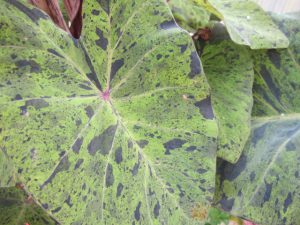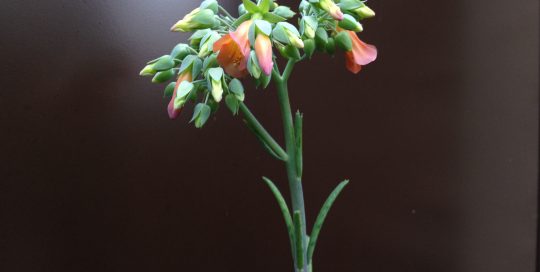Growing Elephant Ears in Containers
Views: 52186

I love Elephant Ears, both the plants and the sugary fried treats at the state fair. For now, we’ll focus on the plant.
I love the giant, leathery leaves of Elephant Ears, and the way the rain beads up on their surface. I love their color variations and the tropical feel they bring to any place they’re planted. Their foliage is so interesting, I don’t have to rely on flowers all season long.
Need I go on?
Elephant Ears, or Colocasia, have been grown for thousands of years in tropical regions as a food crop. They are thought to be native to Southeast Asia. Both their root and leaf are edible. However, must be processed properly before eating to break down the calcium oxalate (so don’t just bite a piece off of the raw leaf). Calcium oxalate is a deterrent to herbivores, so this is a great plant to use in containers if you have issues with deer.
How to Plant an Elephant Ear
It depends on whether you’re starting with a plant or the bulb. Most Elephant Ear varieties will need a container that is at least 18 inches wide and deep. It is a good idea to place a large stone or two in the bottom of the container for weight. The large leaves of Elephant Ears catch the wind like a sail. This will easily tip the container over.
If starting with a plant, simply place it so the soil line is at the same depth as it came, or where the leaves meet the bulb. If starting with the bulb, plant so the root end is pointed down. The top of the bulb is around 4 inches deep. Since the base of the plant is narrow, feel free to plant filler plants around the edge of the container like Coleus, Impatiens, or Dragon Wing Begonias. Creeping Jenny makes an excellent “spiller” plant as well.
Plant Care
Elephant Ears grow naturally in both sun and shade in moist areas. Growing those huge leaves requires plenty of nutrients in addition to lots of water. Water regularly and feed them every few weeks with a balanced fertilizer.
For gardeners in Zone 7 or lower (basically anywhere with a cold winter), there are two ways to overwinter an Elephant Ear. Either cut off most of the older leaves and bring in as a houseplant before the first frost, or let the foliage die back naturally outdoors and dig the bulb up after the first frost to store in a dry cool place until spring.
If choosing the houseplant option, be sure to cut back on water and stop fertilizing, since the plant will be in a semi-dormant phase until the following spring.
A note to those in Zone 8 or higher: Elephant Ears have become invasive plants along streams and wetland areas. Please be responsible if you live near one of these ecosystems and refrain from growing Elephant Ears.
Meet Abbi Hayes
Abbi's Recent Posts

Kalanchoe delagoensis: Mother of Millions







